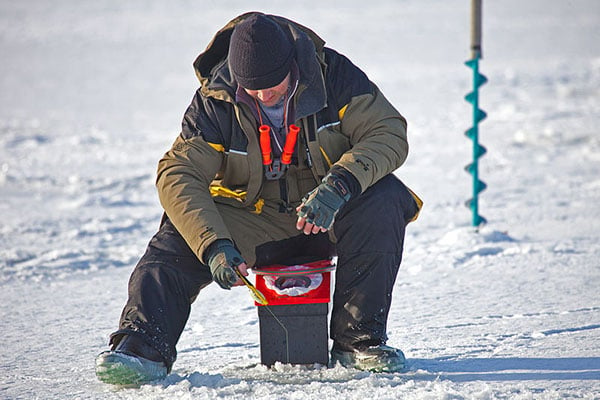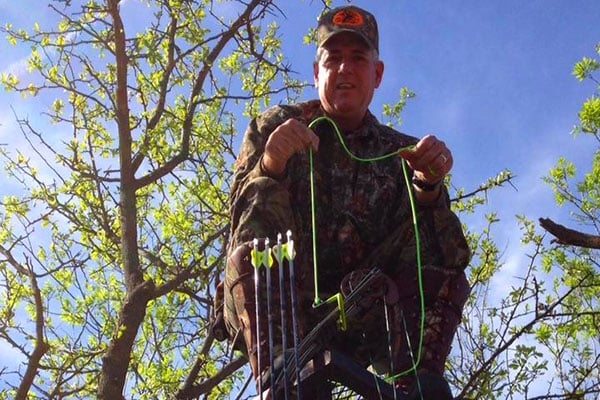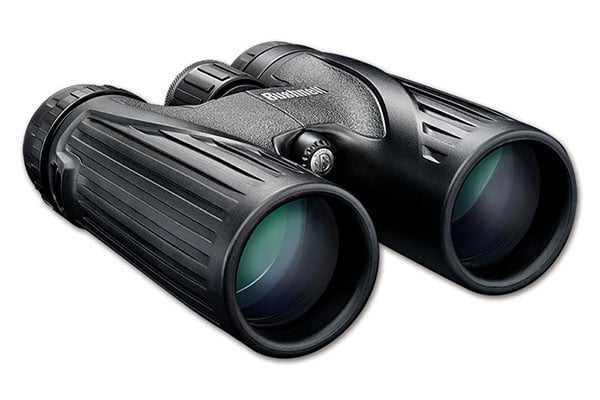Last Updated on
This winter season, countless fisherman will head off into cold temperatures to find that perfect fishing spot on an icy pond. While there are plenty of seasoned ice fisherman who have their time tested gear list and approach all laid out, many others want to try or increase their time ice fishing this year. It all starts with the proper gear like many outdoor activities, but for those who don’t know quite where to start, here is a checklist of ice fishing gear to make your next (or first) outing successful.
Ice Tools
Before you can set a line or haul in a fish, you need to get a suitable circular or rectangular ice hole set up. Here are some tools to get the job done.
Ice Auger
Augers are the primary tools used to drill a suitable fishing hole into the ice, and they come in three primary varieties: hand driven, gas / propane powered and electric. Depending on how and where you fish, you may need more power in your auger, but the best place to start for a casual fisherman is a hand auger. These are the cheapest versions of augers, and they’re sure to get the blood pumping when you’re out on the ice.
However, if you fish often or plan on placing several different holes throughout the course of a day, a gas or electric powered auger is a prudent upgrade. These devices have an engine and handles affixed to the top of the auger blade, and while you can drill a hole quickly with these augers, they are going to cost significantly more vs. a hand powered auger. Pay attention to overall horsepower and the size of the blade (usually 8″ – 10″) when selecting an auger, and it’s not a bad idea to invest in extra fuel like propane canisters if the device calls for it.
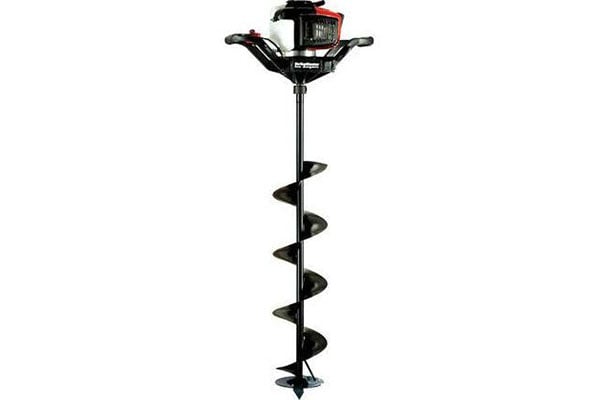
Auger Extensions
Those who live in very cold climates where the ice gets extra thick will want to add an auger extension to their kit. Once they get so far down in the ice, an auger extension allows the blade to cut through the remainder of the ice while still allowing the user to operate the auger safely and effectively.
Auger Blade Guards
Finally for transport, safety and long blade life, an affordable blade guard is a good idea for anyone who owns an auger. Blade guards are usually magnetic or snap on and are an easy add-on for any ice fisherman.
Ice Scoop / Slush Dipper
This simple tool is designed to clear the hole of excess ice and slush to make the fishing process easier. Ice scoops are shaped similar to a soup ladle although they are typically more robust and longer. These scoops have holes in the bottom of the scoop so water can escape while you clean the hole of ice and slush. These are a must have for every level of ice fisherman.
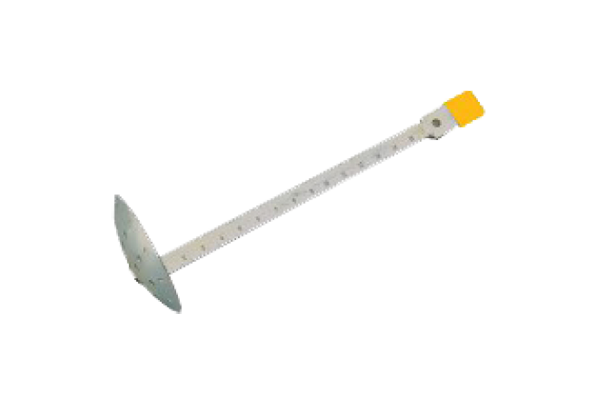
Ice Hole Cover
One last ice hole accessory is a cover to help keep the hole open longer, especially in extremely cold temperatures. Covers are typically made from plastic or rubber, and they can be either clear or solid in color. Covers still have one or several holes for your line while you fish.
Rods And Tackle
Once your ice hole is ready for fishing, you’ll want to break out all your fishing gear.
Ice Fishing Rod And Reel
Ice fishing rods are typically light and small reels that make it easy to cast a line down an ice hole even when confined in an ice fishing shelter. Selection of a rod and reel combo is dependent on brand preference and price point. A rod holder is a good accessory for those who decide to use an ice fishing rod and reel.
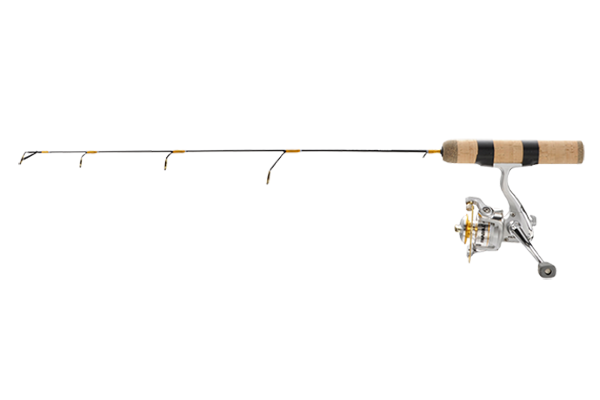
Tip Ups
As an alternative, many ice fisherman rely on tip ups which are rigs with fishing line attached to them that fit over an ice hole. Whenever a fish takes the bait on a tip up, it triggers a flag that alerts the fisherman so they can haul the fish in. The advantage to a tip up is that many can be set at a time increasing the odds of catching a fish.
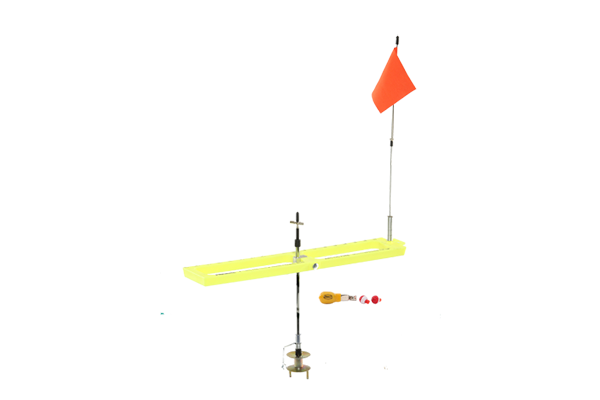
Ice Fishing Tackle
Ice fishing depends upon the use of various sinkers, brightly colored bait and worms, flashing lures and sometimes live bait to hook fish. The selection of the right bait will naturally depend on where you are fishing and what species you are after. Once you select a good bait for the job, don’t forget to add needle nose pliers, mouth spreaders and something to cut fishing line to your box.
Depth Finder
One other tool to consider is a depth finder. After all, you can’t be quiet sure of the conditions and depth under the ice, and a depth finder takes the guessing game out of the equation. Some prefer the cost-effective method of using clip-on depth finders to adjust their float depth, but there are a variety of high-tech depth finders on the market for those who want something more substantial. Ice fishing sonar devices and underwater cameras are now more popular than ever in ice fishing. It’s all about how you want to customize your experience with extra technology. Of course, some will always prefer the low tech method, and that is always a good place to start.
Apparel and Extras
You’ll be facing some biting winds, low temperatures and either bright sun rays or falling snow while ice fishing, and don’t forget that you’re bound to get a little wet as you set up each ice hole for fishing. Here are some extras to keep you warm and comfortable.
Boots
Warm waterproof boots are a must for any ice fisherman as there’s bound to be some exposure to water while working on the ice hole, and nothing spoils an ice fishing session quite like cold and wet feet, so you’ll need to be prepared. Warm socks and heated insoles or heat pads are never a bad idea either.
Gloves
Neoprene gloves are an important addition to any ice fishing kit as they will allow you to work without the worry of keeping your gloves absolutely dry. However, you’ll also need thin, functional gloves for those times where you are waiting for the fish to bite. Some prefer fingerless gloves for this task while others just keep their hands in their pockets, but whatever you do, make sure you have heavy duty waterproof gloves for the ice drilling.
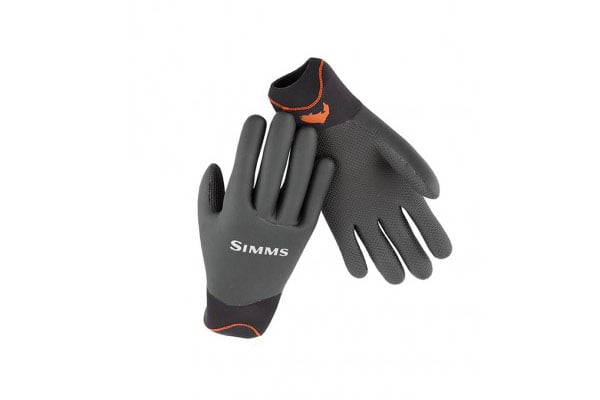
Base Layer
A good, breathable base layer is another prudent investment for anyone who spends an extended time out in winter temperatures. A quality base layer is an investment that can be used for hunting and other winter activities as well, and it is wise not to overlook this layer. A base layer will keep the chill off during those times when you’re less active, but breathable fabric will ensure you don’t sweat and chill when you have to increase activity.
Ice Suit
Once you have your extremities covered, you’ll need some serious primary apparel for a long day of ice fishing. While some prefer a hardy parka, the safest and warmest option is found in an ice suit. Ice suits usually consist of a bib and jacket combo, and breathable materials with waterproof finishes are important to look for here too. Certain ice suits can also provide positive buoyancy, and when combined with a life jacket can help keep the user afloat in an emergency.
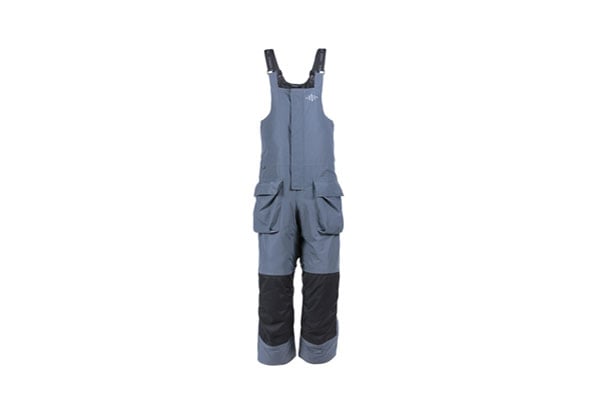
Ice Cleats
Keep your feet firm on the ice when performing demanding tasks with a pair of ice cleats or chains. These devices snap on to your boot and help prevent sliding and slipping while on the ice. These are must-have accessories for anyone who wants to ice fish safely.
Ice Shelter
Once you get your hole all set up and you’re ready to fish, you still have to withstand the elements for many hours depending on your resolve and desire to catch a fish. While some only fish casually, others make a day out of it by bringing along a portable ice shelter. These shelters ensure that the wind and elements are too harsh on the fisherman, and they can help keep the ice hole clear when combined with a portable heater. Portable ice shelters range from small one man tents to larger multi-person shelters, and while more space is always better, larger shelters will require more setup time.
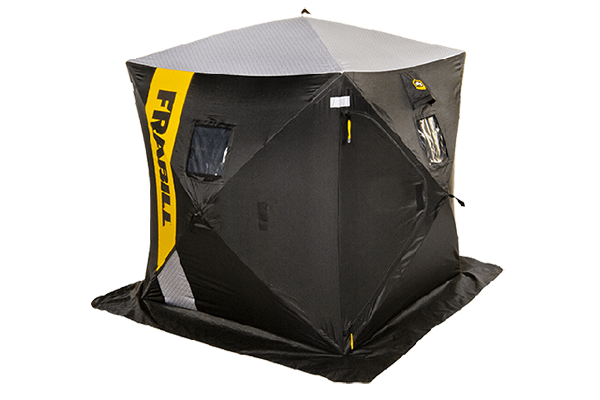
Ice Anchors
If you decide to go the route of an ice shelter, ice anchors are a necessary accesory to add to your kit. Ice anchors screw into the ice and provide a firm hold for any portable shelter. While many shelters come with ice anchors included, it’s never a bad idea to have some spares on hand. You’ll also want to think about how to best place ice anchors into the ice. Most have luck with screw in anchors, but keep in mind that using hammer in anchors can cause the ice to crack and you’ll have to start someplace new. Other fisherman have resorted to drilling starter holes with a portable drill for speed, and then screwing in the anchor the rest of the way.
Thumb courtesy of Wikimedia Commons.
